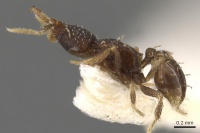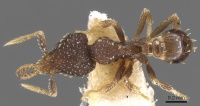Strumigenys ettillax
| Strumigenys ettillax | |
|---|---|

| |
| Scientific classification | |
| Kingdom: | Animalia |
| Phylum: | Arthropoda |
| Class: | Insecta |
| Order: | Hymenoptera |
| Family: | Formicidae |
| Subfamily: | Myrmicinae |
| Tribe: | Attini |
| Genus: | Strumigenys |
| Species: | S. ettillax |
| Binomial name | |
| Strumigenys ettillax Bolton, 1983 | |
A few collections of this species have been obtained from leaf litter sampling in rainforest.
Identification
Bolton (2000) - A member of the Strumigenys scotti-group. Mandibles stout and relatively short, the outer margins weakly convex and each blade suddenly narrowed at base. Scape short (compare with SI range for remainder of group), weakly dorsoventrally flattened and with a convex leading edge that is equipped with a row of curved, narrowly spoon-shaped hairs. Preocular notch absent. Upper scrobe margin fringed with a row of large spoon-shaped hairs that are much larger than those on the leading edge of the scape.
Keys including this Species
Distribution
Latitudinal Distribution Pattern
Latitudinal Range: 2.06889° to 2.06889°.
| North Temperate |
North Subtropical |
Tropical | South Subtropical |
South Temperate |
- Source: AntMaps
Distribution based on Regional Taxon Lists
Afrotropical Region: Cameroun (type locality), Gabon.
Distribution based on AntMaps
Distribution based on AntWeb specimens
Check data from AntWeb
Countries Occupied
| Number of countries occupied by this species based on AntWiki Regional Taxon Lists. In general, fewer countries occupied indicates a narrower range, while more countries indicates a more widespread species. |

|
Estimated Abundance
| Relative abundance based on number of AntMaps records per species (this species within the purple bar). Fewer records (to the left) indicates a less abundant/encountered species while more records (to the right) indicates more abundant/encountered species. |

|
Biology
Castes
Nomenclature
The following information is derived from Barry Bolton's Online Catalogue of the Ants of the World.
- ettillax. Strumigenys ettillax Bolton, 1983: 371 (w.) CAMEROUN. See also: Bolton, 2000: 608.
Unless otherwise noted the text for the remainder of this section is reported from the publication that includes the original description.
Description
Worker
Holotype. TL 2.0, HL 0.57, HW 0.46, CI 81, ML 0.23, MI 40, SL 0.27, SI 59, PW 0.30, AL 0.52.
Mandibles stout, the outer margins shallowly convex in full-face view and sharply incurved basally where the blades suddenly narrow to their insertions. Apical fork of each mandible with 2 spiniform teeth, without intercalary teeth or denticles. Each mandibular blade with 2 stout preapical teeth, the proximal about one-third longer than the distal and their bases separated by a distance which is slightly less than the length of the distal pre apical tooth. Upper scrobe margins very feebly sinuate in full-face view, bordered by a narrow rim or flange and meeting the sides of the occipital lobes (at the scrobal apices) in an obtuse but distinct angle, the upper scrobe margins not merging smoothly into the sides of the occipital lobes. Eyes of moderate size, with 5 ommatidia across the greatest diameter and with 15 or more ommatidia in all. Maximum diameter of eye greater than the maximum width of the scape. Preocular notch absent, ventral surface of head without a transverse pre ocular groove or impression. Antennal scapes narrow and shallowly curved basally, expanded in the meqian third and with the leading edges equipped with a row of apically curved spoon-shaped hairs which are distinctly smaller than those fringing the upper scrobe margins. Ground-pilosity of cephalic dorsum of inconspicuous small flattened hairs, the upper scrobe margins with a row of large spoon-shaped hairs. Dorsum of head with 6 standing hairs, arranged in a transverse row of 4 close to the occipital margin and a more anteriorly situated pair. Dorsum of head densely reticulate-punctate. Pronotal humeri each with a fine flagellate hair. Mesonotum with a single pair of stout standing hairs which are thickened apically. Ground-pilosity of dorsal alitrunk of inconspicuous small hairs like those on the head. Posterior portion of mesonotum very slightly depressed behind the level of the pair of hairs, the metanotal groove forming a weak line across the dorsum. Propodeal teeth short and triangular, subtended by relatively broad infradental lamellae which at their broadest extend posteriorly almost as far as the apices of the teeth. Sides of pronotum feebly punctate-striolate, the pleurae and sides of propodeum mostly smooth but with some peripheral punctate sculpture. Pronotum finely and quite densely longitudinally rugulose, the remainder of the dorsal alitrunk reticulate-punctate. Dorsum of petiole node finely punctate, the postpetiole smooth. Ventral spongiform strip of petiolar peduncle narrow, broadening beneath the node. Lateral spongiform lobe of postpetiole equal to or slightly exceeding the exposed area of the disc in profile. In dorsal view the lateral spongiform material is visible, projecting beyond the outline of the sides of the postpetiole. Basigastral costulae sparse, 5-6 arising on each side of a narrow clear central area. Petiole, postpetiole and gaster dorsally with stout standing hairs which are thickened apically. Colour blackish brown.
Paratypes. TL 2.0, HL 0.53-0.54, HW 0.43-0.44, CI 81, ML 0.23, Ml 42-43, SL 0.26, SI 59-60, PW 0.27, AL 0.50-0.52 (2 measured).
As holotype but one lighter in colour than the holotype and probably teneral.
Type Material
Holotype worker, Cameroun: nr Yaounde, series IY (G. Terron) (Ecole Nationale Superieure Agronomique). Paratypes. 2 workers with same data as holotype but one series AM, the other series TR (ENSA; The Natural History Museum).
References
- Bolton, B. 1983. The Afrotropical dacetine ants (Formicidae). Bull. Br. Mus. (Nat. Hist.) Entomol. 46: 267-416. (page 371, worker described)
- Bolton, B. 1995b. A new general catalogue of the ants of the world. Cambridge, Mass.: Harvard University Press, 504 pp. (page 396, catalogue)
- Bolton, B. 2000. The ant tribe Dacetini. Memoirs of the American Entomological Institute. 65:1-1028.8 (page 608, redescription of worker)
References based on Global Ant Biodiversity Informatics
- Bolton, B. 2000. The Ant Tribe Dacetini. Memoirs of the American Entomological Institute 65

